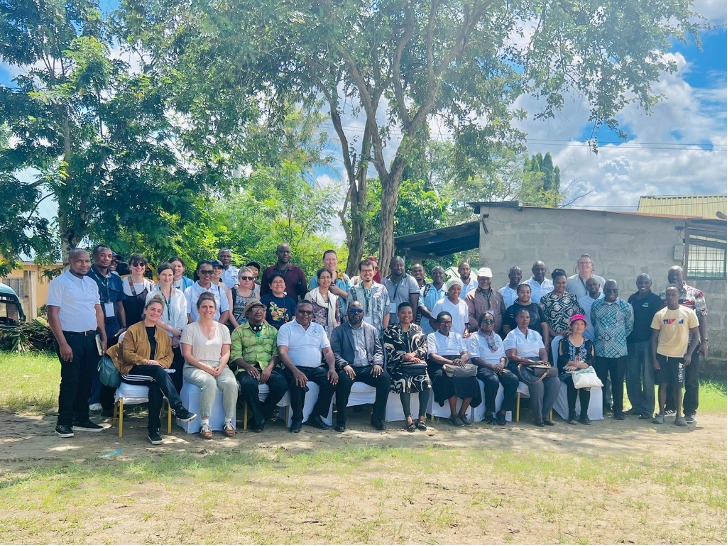
Philanthropy has a timely opportunity to elevate agrochemical reform as an effective measure that delivers benefits for farmers, communities, and the climate.
Agrochemicals are often overlooked in conversations about climate and food systems, even though they are a significant contributor to global greenhouse gas emissions. Nonetheless, efforts to reduce dependence on agrochemical fertilizers, pesticides, and herbicides present a major opportunity to improve climate and human health.
From India to East Africa, the adoption of agroecological practices is already demonstrating that healthy agricultural yields are possible without toxic, fossil-based inputs. With COP30 and other major climate convenings on the horizon, philanthropy has a timely opportunity to elevate agrochemical reform as an effective measure that delivers benefits for farmers, communities, and the climate.
The impact of agrochemicals on climate, people, and ecosystems
Globally, fertilizers are responsible for more than 5% of greenhouse gas emissions — on par with emissions from the entire European Union. Ammonia synthesized for nitrogen fertilizers accounts for 3% to 5% of global fossil gas consumption, and about half of all nitrogen fertilizers applied to soil run off into waterways, creating “dead zones” where most aquatic life dies or migrates away. Fertilizers also account for more than 60% of anthropogenic emissions of nitrous oxide (N₂O), a greenhouse gas nearly 300 times more potent than carbon dioxide. N₂O emissions are rising faster than anticipated, but action today could stabilize emissions long-term.
As momentum builds around COP30, there is a growing yet underfunded effort to elevate N₂O on the global climate agenda. Unlike CO₂ or methane, there are no major global treaties or philanthropic initiatives targeting N₂O reduction. Philanthropy has the flexibility to fund overlooked but high-leverage interventions, support coalition-building, and elevate bold policy proposals.
Not only do agrochemicals contribute to harmful emissions; they also pose risks to human health (and may have links to cancer and infertility), contaminate soil and water, and threaten biodiversity. Overfertilization leads to nitrate pollution in water bodies, threatening ecosystems and human health. In Europe, nitrates pollution due to runoff left 200,000 people without drinking water in Spain in 2022, and is costing taxpayers tens of billions of euros annually. Agrochemical production can also pose a threat to local communities: for example, residents in the petrochemical corridor between Baton Rouge and New Orleans, Louisiana, which has been nicknamed “Cancer Alley,” have a 95% higher risk of contracting cancer than the average U.S. resident.
Agrochemical reform is an area ripe for catalytic action. However, barriers to progress include powerful industry lobbies, entrenched food security narratives, and weak incentives for sustainable agriculture.
How corporate consolidation shapes power, policy, and impacts
Just a few corporations control more than half of the global agrochemicals market, wielding extraordinary power over what farmers grow and how they are produced. This is one of the most extreme examples of corporate concentration in any sector.
The agrochemicals industry exercises its consolidated power by influencing public discourse and shaping the global climate agenda, as seen during previous negotiations at UN climate conferences. The industry hinders the agrochemicals transition by deploying a powerful narrative that agrochemicals are indispensable for food security, and positioning itself as a leader in climate and biodiversity innovation.
Contrary to the public image they cultivate, these agrochemical companies remain deeply tied to fossil fuels. They frame low-emission ammonia fertilizer production as a solution to decarbonize the sector, but these efforts fall short without broader systemic changes. “Alternative ammonia” has been revealed as little more than greenwashing, distracting from the need for holistic measures such as shifting to agroecological practices. Ammonia-based fertilizers — regardless of how they are produced — do not reduce N₂O emissions, and overfertilization leads to harmful effects on human and ecosystem health. Replacing one harmful input with another does not work.
Instead, it is necessary to develop more holistic approaches that prioritize soil health, crop diversification, nutrient and biomass recycling, and reduced dependence on external inputs. Such strategies not only cut emissions but also strengthen resilience to climate and economic shocks. As with any reforms, economic, social, and political context matters, and there is no one-size-fits-all transition pathway. Sri Lanka’s short-lived agrochemicals ban in 2021 illustrates how measures to transition farming systems without holistic support can actually make problems worse.
The path toward ending agrochemical dependence
Meaningfully reducing agriculture’s reliance on agrochemicals requires moving beyond piecemeal solutions and committing to systems-level transformation. The following steps outline a pathway to ending agrochemical dependence:
- Unify around one clear narrative: Make the case that there is no true food security while food systems remain reliant on agrochemicals.
- Elevate frontline leadership: Scale solutions and amplify messages already being driven by farmer organizations, grassroots movements, and frontline communities.
- Drive synthetic input reduction: Halt the growth of agrochemical production and build strong alliances with communities to expose industry pollution.
- Replace harmful chemicals with safer alternatives: Create enabling conditions for new farmer-led and low-carbon soil health and crop protection innovations to thrive.
- Transform food systems: Transition to agroecological, regenerative, and organic practices that reduce reliance on chemical inputs and build resilient local food systems.
Aligning funders for systemic wins
Collaborative philanthropic efforts can help achieve systemic wins for farmers and communities that also deliver on climate benefits. However, efforts to date have been fragmented and underfunded. Philanthropy must support holistic solutions, break free of siloed approaches, and confront vested interests in our economy, while working toward unified narratives and messaging. At the global level, funders can learn from other collaborative philanthropy efforts on climate, such as the drive to reduce methane emissions, which involved bringing key actors together, pooling resources, and advancing landmark commitments like the Global Methane Pledge.
Now is the time for collaboration, and upcoming milestones at New York Climate Week, COP30, and the United Nations Environment Assembly present opportunities for partnership across sectors. By investing in alternative narratives and scaling proven solutions, philanthropy can help drive meaningful change for people and the planet.
Stay tuned for Part Two of this series, which will explore how ClimateWorks’ partners are scaling solutions on the agrochemicals transition, and how their work is connected to the broader food systems transformation efforts. The piece will showcase on-the-ground approaches that are gaining momentum with philanthropy’s support — such as building evidence and raising awareness of the impacts of agrochemical use; advancing farmer-centered innovations for soil health and crop production; and expanding access to finance and de-risking tools.




